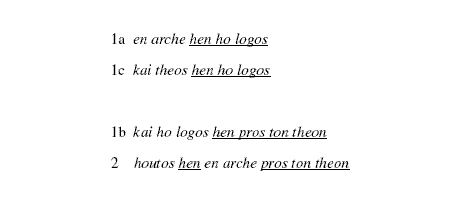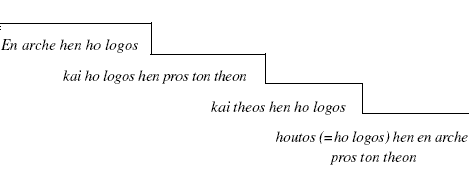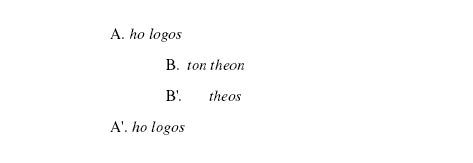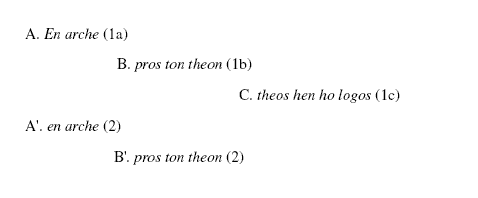
Logos and Theos in John 1:1-2
The Colwell Rule of New Testament Greek grammar has been marshaled by defenders of the deity of Christ to deflect the suggestion that John 1:1c (theos hen ho logos ="the Word was God") assigns a divine quality to the Logos/Word, not divine essence. Colwell's Rule is rushed to the defense of the Word's essential deity on the grounds that nouns in the predicate which both lack the definite article (i.e., are anarthrous) and precede the verb are not qualitative, but definite. Since John 1:1c finds theos in the anarthrous state and before the verb (hen), Colwell's Rule requires definite force, i.e., God (cf. Leon Morris, Commentary on the Gospel of John [Grand Rapids, MI: Wm. B. Eerdmans Publishing Co., 1971] 76-79).
However, the admirable intent of the defenders of our Lord's essential deity requires a more nuanced application of Colwell's Rule. "Colwell stated that a definite PN [Predicate Nominative—JTD] that precedes the verb is usually anarthrous. He did not say the converse, namely, an anarthrous PN that precedes the verb is usually definite. However, this is how the rule has been misunderstood by most scholars . . . " (Daniel B. Wallace, Greek Grammar Beyond the Basics [Grand Rapids, MI: Zondervan, 1996] 260, emphasis in the original; cf. his full discussion of our text, pp. 266-69). The traditional translation, "the Word was God", must be defended on other grounds, i.e., theology, syntax, grammatical context, etc. (see below). The deity of the Logos (God with a capital "G") is defensible in spite of anarthrous theos.
If the translation affirming the essential deity may be supported from the context, the syntax, and the grammatical factors, a reductionist translation (such as that of the Jehovah's Witnesses in their New World Translation) perverts the meaning of this passage. In order to render John 1:1c "the Word was a god", the New World Translation must continue the charade of claiming to translate the anarthrous theos by "a god" everywhere in the New Testament. In fact, as Robert Countess has demonstrated, the Jehovah's Witnesses are 94% unfaithful to their own rule of translation. Out of 282 instances of the anarthrous theos in the New Testament, the New World Translation renders 266 by "God", not "a god" or "godly" or "god(s)". Only 16 out of 282 (a meager 6%) instances are rendered according to the New World Translation canon of distinguishing arthrous from anarthrous theos (cf. Robert Countess, The Jehovah's Witnesses' New Testament: A Critical Analysis of the New World Translation of the Christian Greek Scriptures (Philipsburg, NJ: Presbyterian and Reformed Publishing Co., 1987). Even in John's Prologue (John 1:1-18), the anarthrous theos appears in verses 6, 12, 13, 18 and the New World Translation translates it "God". Why then does the New World Translation translate the anarthrous theos in v. 1c and v. 18 (monogenes theos) "a god/god"? The answer is patent: theological bias. Arianism, ancient and modern, refuses the essential deity of the Son. He is ever a creature, always a creature, nought but a creature.
The threefold definition of the Logos/Word (John 1:1-2) proceeds on the basis of identity and distinction. The Logos/Word is identified with God, while being distinguished from God. The second phrase ("and the Word was with God," John 1:1b) suggests this distinction, i.e., the Logos/Word stands alongside ("with") God. Yet the first and third phrases (John 1:1a and 1c) suggest his identity with God. Thus the Logos/Word is God, while being a distinct person alongside of his Father (the Logos/Word's favorite term for designating God in the fourth gospel). There are therefore at least two persons in the Godhead designated Father and Son (especially in John's gospel). We may paraphrase John 1:1—In the beginning was God the Son, and God the Son was with God the Father, and God the Son was God (as God the Father is God).
I would like to examine the structure of John 1:1, 2 in order to determine whether any fresh evidence of Logos-Theos equivalence may be found. In other words, is it possible to support the orthodox Trinitarian consensus from other aspects of the text? Let us begin by counting terms/words. Verse 1a reads En arche hen ho logos (5 words); verse 1b reads kai ho logos hen pros ton theon (7 words); verse 1c reads kai theos hen ho logos (5 words); verse 2 reads houtos hen en arche pros ton theon (7 words). NB: there are no variants in the text critical apparatus of John 1:1, 2. We discover that the alternating clauses contain parallel word totals. We also discover that the alternating clauses contain parallel (even identical) phrases.

Taking the non-parallel terms in 1a and 1c, we are left with en arche and theos ("in the beginning" and "God"). "In the beginning God" is an emphatic reminiscence of Genesis 1:1 (En arche . . . theos, LXX)—hence a creation/new creation paradigm. It is also a clear declaration that before the beginning (i.e., creation), God was already existent. In fact, before the beginning, God was; before the beginning of creation, there was (in existence) nothing but God. John's affirmation of the eternal existence of God is fully supported by biblical affirmations throughout the Old Testament and New Testament. Thus, the first two parallel sections (v. 1a and v. 1c) place the Logos/Word in duplicate positions, while leaving God's being (theos) expressed by the corresponding phrase "in the beginning"=from all eternity.
This brings us to v. 1b and v. 2. The parallels hen pros ton theon leave non-parallel ho logos and en arche. Again, this is a clear declaration of the eternality of the Logos/Word—he was en arche ("in the beginning"). Thus our second set of parallel clauses (v. 1b and v. 2) place "with God" in parallel positions, while leaving the Logos's being expressed by the corresponding phrase "in the beginning"=from all eternity.

In addition to—in fact building upon—the particular parallelisms in the clauses is the phenomenon of equivalence. In v. 1a and v. 1c, theos is en arche. In v. 1b and v. 2, ho logos is en arche. An old axiom teaches that quantities equal to the same quantity are equal to each other. In this case, God is in the beginning; the Logos/Word is in the beginning. Therefore God is equivalent to the Logos/Word.

Less mathematically, but no less truly: if eternality is predicated of the Logos/Word and eternality is predicated of theos (God), then the Logos/Word shares the incommunicable attribute of divine eternality. In other words, Logos/Word is eternal (God) as God is eternal God.
The first two verses of John's magnificent Prologue are a taut, indeed parallel declaration of the deity and eternality of the Logos/Word.
But there is more. The literary form of these two verses is a fascinating stair step parallelism. Notice how the word which ends a clause is the word which begins the next clause in step down or stair step fashion.

As we follow this literary, staircase device, we notice that it is not merely aesthetic. It is theological. What is said of logos/Word is said of theos/God. There is in fact a prefect symmetry or balance between the occurrence of the terms logos and theos. Verse 1a ends with logos and v. 1b begins with logos; v. 1b ends with theos and v. 1c begins with theos. Thus far a double symmetry in John's stair step pattern. It would appear that the end of v. 1c and the beginning of v. 2 break the pattern. But on closer examination, v. 1c and v. 2 are a recapitulation of the balanced symmetry of 1a, 1b and 1c (first term). Notice that 1c ends with logos and v. 2 ends with theos. The symmetry is not broken or abandoned; it is preserved in a (single) balance or equivalence between terms used in the previous stair step paradigm. It is as if John epexegetically reinforces his staircase pattern with a final, emphatic declaration that Logos and Theos are co-essential. In other words, as the staircase pattern brings Logos and Theos together in duplicate, symmetrical fashion, so outside the staircase (v. 1c, final words and v. 2), Logos and Theos are also symmetrical. In fact, the clue to the relation of Logos and Theos is found both in the stair step pattern as well as the pattern of equivalence. Can there be any question that John equates Logos and Theos? Surely not for those with structural (as well as grammatical) eyes to see.
Finally, if the staircase paradigm is a symmetrical revelation of Logos-Theos identification (the Logos is God, second person of the ontological Godhead), then we should expect equivalences inside the clauses of these verses. Notice then what happens when we bracket v. 1b and v. 1c.

In fact, we discover a chiastic pattern in the bracketing.

Or alternatively:

The chiasm is a reciprocal paradigm of identity. Again, John's taut literary structure declares the equivalence of Logos and Theos. They are (chiastically) reciprocal and therefore identical. Structurally, from the chiastic arrangement of the terms, the Logos/Word is God.
But what about v. 1a and v. 2? Again, we discover two terms of our discussion—Logos and Theos—but here we find them in parallel fashion.

Consistent with John's literary structuring device of parallelism elsewhere (i.e., vv. 1b and 1a), he provides a straightforward balance between Logos and Theos from the beginning. Here is another clear indication of essential deity (with personal distinction and hence no Sabellianism) between Logos and Theos.
The heart of this identification is found explicitly in v. 1c: kai theos hen ho logos. The verb "to be" (hen) is an equals sign: kai theos=ho logos. The predicate nominative reveals that the left side and the right side of the verb "to be" are relationally symmetrical (e.g., Jim is a boy means boy=Jim and Jim=boy). Here, God was the Logos means God=Logos (and Logos=God).
If we consider yet another arrangement, we note the following:

The parallel clauses (A/A' and B/B') surround the centrally unique clause (C). Not a chiasm, this is a concentric parallelism built around (and centering/focusing upon) the key element in John's kerygma: Theos-Logos. We can even define this final paradigm as a stair step, concentric parallelism centered upon the equivalence of Logos and Theos. This recognition also is appropriate to the concentric (and parallel) word counts noted above: 5 (1a), 7 (1b), 5 (1c), 7 (2).
Grammatically, structurally, staircase paradigmatically, chiastically, concentrically, parallelistically: Jesus of Nazareth (the incarnate Logos, cf. John 1:14—"the Word was made flesh and dwelt among us") is God—God, the Son—for he is the Logos whom John declares to be Theos. Well might we fall down with Thomas at the end of John's gospel (20:28), even as we fall down at the beginning of John's gospel and confess: Logos—my Lord and my God (theos)!
Northwest Theological Seminary
Lynnwood, Washington
(I want to express my thanks to Tin L. Harrell, Registrar and Adjunct Instructor in Greek at Northwest Theological Seminary, for her helpful suggestions on this article, especially the material on the Colwell Rule.)